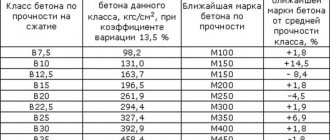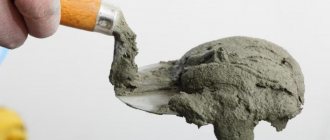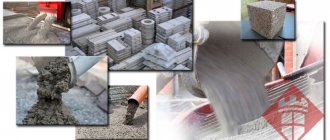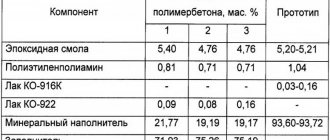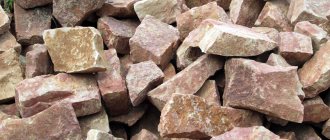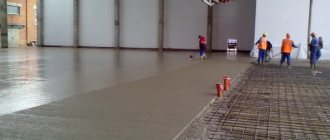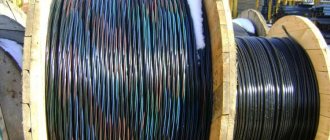- home
- Helpful information
In order for the finished concrete product, after pouring, to gain the necessary design strength and serve for many years, it is necessary to observe the temperature regime during hardening. The optimal temperature for concrete hardening is +20C, at which concrete gains strength in 28 days. But what if you are pouring the foundation in the fall, when the air temperature is just above zero? Modern technologies make it possible to cope with this problem. Moreover, subject to certain measures, concrete work can be carried out even in winter.
The process of strengthening concrete structures
To answer the question: “At what temperature can concrete be poured?”, it is necessary to understand what happens to concrete during hardening. After preparing the concrete mixture, a chemical reaction between water and cement begins to occur. This process is called cement hydration, which goes through two stages:
- setting
- hardening
During setting, aluminates (C3A) participate in the reaction. As a result, needle-shaped crystals are formed that bond with each other. After 6 - 10 hours, a kind of skeleton is formed from these crystals.
From this moment, concrete hardening begins. Here clinker minerals (C3S and C2S) already react with water and a silicate structure begins to form. As a result of this reaction, small crystals are formed, which combine into a finely porous structure, which is essentially concrete.
Melting temperature of concrete
This leads to increased internal stress in the concrete, and as a result, to its cracking and destruction. The frost resistance of concrete is lower, the greater the access to moisture penetration: the volume of pores in which water can accumulate, macroporosity and the level of capillary porosity.
Increasing the frost resistance of concrete occurs due to a decrease in macro- and microporosity, as well as the introduction of hydrophobic air-entraining additives.
With their help, reserve pores are formed in concrete that are not filled with water under normal conditions. When water that has already entered the concrete freezes, part of it moves into these pores, thereby relieving internal pressure.
The use of aluminous cements also increases the frost resistance of the material. For hydraulic structures, a frost resistance grade of concrete from F is required, and for those erected in areas with a harsh climate - from F. The specification is made based on the average daily temperature for a given region. The destruction of concrete under the influence of liquid media occurs not only at subzero temperatures.
The influence of negative temperature on concrete hardening
The rate of hydration is highly dependent on temperature. Reducing the temperature from +20C to +5C increases the hardening time of concrete up to 5 times. But the reaction slows down especially sharply with a further decrease to 0C. And at negative temperatures, hydration stops, because... the water freezes. As you know, water expands when it freezes. This leads to an increase in pressure inside the concrete mixture and destruction of the formed crystal bonds. As a result, the concrete structure is destroyed. Also, the resulting ice envelops large elements of the mixture aggregates (crushed stone, reinforcement), destroying their bonds between the cement paste. This leads to deterioration of the solidity of the structure.
When the water thaws, the hardening process resumes, but with a deformed concrete structure. Which can lead not only to detachment of reinforcement and large aggregate elements of the concrete mixture, but also to cracks. Naturally, the strength of such a concrete structure will be much less than the calculated one.
It should be noted that the earlier the concrete was frozen, the less its strength will be.
Impact of high temperatures on concrete
Under the influence of high temperatures, various negative processes occur in concrete:
| 250 – 300 degrees Celsius | Strength decreases, which is accompanied by the process of decomposition of calcium hydroxide and oxide. In this case, the structure of the cement stone is destroyed. |
| 550 degrees Celsius | At this temperature, quartz grains, which are present in sand and crushed stone for concrete, begin to crack and the quartz passes into another form - tridymite. Cracking is caused by an increase in quartz grains in volume. In this case, microcracks appear in the structure of the formation at the points of contact between the cement stone and the filler. |
| Over 550 degrees Celsius | With a subsequent increase in temperature, other structural elements of concrete are also destroyed. |
In the photo - heat-resistant concrete
Concreting in winter
Since low temperatures significantly reduce the hardening rate, and frost has a detrimental effect on the structure as a whole, the concrete must be warmed. Moreover, it is necessary to ensure uniform heating. The minimum temperature for pouring concrete should be above +5C. If the temperature inside the mixture is higher than the temperature outside the mixture, this can lead to deformation of the structure and the formation of cracks. Concrete is heated until critical strength is reached. If there is no data in the design documentation about the value of the critical strength, it should be at least 70% of the design strength. If requirements are established for frost resistance and water resistance, then the critical strength must be at least 85% of the design strength.
When pouring concrete at sub-zero temperatures, different technologies for heating the concrete are used. The most commonly used methods are:
- Thermos
- Electric heating
- Steam heating
Thermos method
This method is used for massive structures. It does not require additional heating, but the temperature of the laid mixture should be more than +10C. The essence of this method is that the laid mixture, while cooling, has time to gain critical strength. The chemical reaction of concrete hardening is exothermic, i.e. heat is released. Therefore, the concrete mixture heats itself. In the absence of heat loss, concrete can heat up to a temperature of more than 70C. If the formwork and open surfaces are protected with heat-insulating material, thus reducing the heat loss of hardening concrete, the water will not freeze and the concrete structure will gain strength.
To implement the thermos method, no additional equipment is required, so it is economical and simple.
Electric heating of concrete mixture
If it is impossible to achieve critical strength gain within the established time frame using the thermos method, then resort to electric heating. There are three main methods:
- warming up with electrodes
- induction heating
- use of electric heating devices
The method of heating with electrodes is as follows: electrodes are introduced into the freshly laid mixture and current is applied to them. When electric current flows, the electrodes heat up and heat the concrete. It should be noted that the current must be alternating, because At constant current, electrolysis of water occurs with the release of gas. This gas shields the surface of the electrodes, current resistance increases and heating is significantly reduced. If the design uses iron reinforcement, then it can be used as one of the electrodes. It is important to ensure uniform heating of the concrete and control the temperature. It should not exceed 60C.
Electricity consumption with this method varies between 80 – 100 kWh per 1 m3 of concrete.
Induction heating is rarely used due to the complexity of its implementation. It is based on the principle of non-contact heating of electrically conductive materials with high frequency currents. An insulated wire is wrapped around the steel reinforcement and current is passed through it. As a result, induction appears and the fittings heat up.
Energy consumption during induction heating is 120 – 150 kW*h per 1 m3 of concrete.
Another method of electric heating of concrete is the use of electric heating devices. There are heating mats that are laid out on the surface of concrete and plugged into the network. You can also build something like a tent over the concrete and put electric heating devices inside, for example a heat gun. But in this case, it is necessary to take care of retaining moisture in the concrete and preventing premature drying.
At an ambient temperature of -20C, the electricity consumption with this method will be 100 - 120 kWh per 1 m3 of concrete.
Steam heating of concrete
Heating concrete with steam is very effective and is recommended for thin-walled structures. On the inside of the formwork, channels are created through which steam is passed. You can make double formwork and let steam pass between its walls. You can also lay pipes inside concrete and pass steam through them. Concrete is heated in this way to 50 - 80C. This temperature and favorable humidity accelerates the hardening of concrete several times. For example, in two days, with this method, concrete gains the same strength as during a week of hardening under normal conditions.
But this method has a significant drawback. It requires significant costs to organize it.
Concreting method in winter
There are several methods for pouring concrete. Its types depend on weather conditions, as well as on the type of structure that is being built. Among the most common:
- Thermos can also be added with anti-frost components.
- Heating formwork.
- Heating using electrodes.
- IR or induction heating.
- Warming up with wires.
READ ALSO: Review of gate valves
In order to have a clearer idea of heating the concrete mixture, we will consider the most relevant methods separately.
Use of additives
Another method of winter concreting is the use of chemical hardening accelerators and antifreeze additives. These include chloride salts, sodium nitrite, calcium carbonate, etc. These additives lower the freezing point of water and accelerate the hydration of cement. Their use allows you to do without heating the concrete. Some additives increase the frost resistance of concrete, thereby hydration occurs even at -20C.
The use of additives has a number of disadvantages. Their presence in the mixture has a detrimental effect on the reinforcement, and the corrosion process begins. Therefore, they can only be used in unreinforced structures. Also, when using antifreeze additives in winter, concrete will gain strength of no more than 30%. When above-zero temperatures occur, thawing and a further process of strengthening will occur. Therefore, additives cannot be used in concrete operating under dynamic loads (foundations for vibrating machines, hammers, etc.).
Destruction under high temperatures
At temperatures above 200˚C, destructive processes start in concrete. The gradual decrease in strength is due to dehydration of the material and the disintegration of binding compounds. The degree of destruction is directly dependent on the increase in the temperature range. Continuous heating of cement stone to 1200˚C leads to a decrease in the strength of experimental concrete samples by up to 35 - 40%. Portland cement breaks down at a temperature of 800˚C. The introduction of various mineral additives into its composition increases the resistance of concrete to temperature influences.
Concreting in dry, hot climates
Along with the cold, concrete is afraid of heat. If the ambient temperature exceeds 35C and humidity is less than 50%, then this contributes to increased evaporation of water from the concrete mixture. As a result, the water-cement balance is disrupted and the hydration process slows down or stops altogether. Therefore, it is necessary to take certain measures to protect the mixture from moisture loss. You can lower the temperature of the freshly prepared mixture by using chilled water, or diluting the water with ice. This simple method will avoid significant loss of water when laying the mixture. But after some time the mixture will heat up, so care should be taken to further seal the structure. The formwork must be airtight to avoid moisture loss through cracks. The absorbent surface of the formwork must be treated with a special compound that limits adhesion to concrete and the absorption of moisture from it.
It is necessary to protect hardening concrete from exposure to direct sunlight. To do this, the surface of the concrete is covered with burlap or tarpaulin. Every 3 - 4 hours it is necessary to wet the surface. Moreover, the moistening period can reach 28 days, i.e. to full strength.
One of the ways to protect against water shortage is to erect an airtight cap made of PVC film with a thickness of at least 0.2 mm over the surface of the concrete structure.
What is heat-resistant concrete
Moisture tends to wash away easily soluble components from any substance, and one of the components when mixing concrete dough, slaked lime, calcium oxide hydrate, is a water-soluble substance.
Its washing out leads to disruption of the structure and destruction of concrete blocks and foundations.
One of the important criteria for concrete to achieve the required strength, compressive strength, is its hardening temperature. Failure to comply with the temperature regime at a construction site can result in a significant increase in the delivery time of the project or, much worse, in defects in the future design.
In addition, acidic components in water also have an adverse effect on the condition of the material. Today, there are various ways to protect concrete from destruction due to moisture.
Penetrating into the structure, they reduce the degree of dehydration and dehydration. Concrete is heat-resistant, manufactured in compliance with technological standards and from correctly selected components. Home Concrete. Date: Characteristics of concrete.
List of concrete grades. Scheme for preparing a concrete mixture. Share this article:. Rate this article: Click here to cancel reply.


